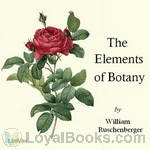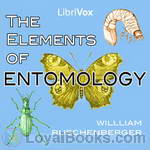|
Books Should Be Free Loyal Books Free Public Domain Audiobooks & eBook Downloads |
|
|
Books Should Be Free Loyal Books Free Public Domain Audiobooks & eBook Downloads |
|
Science |
|---|
Book type:
Sort by:
View by:
|
By: William Ruschenberger (1807-1895) | |
|---|---|
 The Elements of Botany
The Elements of Botany
The Elements of Botany is one of seven in a Series of First Books of Natural History Prepared for the Use of Schools and Colleges. It is a succinct little textbook that presents a solid introduction to plant science. | |
 The Elements of Entomology
The Elements of Entomology
The Elements of Entomology is one of seven in a Series of First Books of Natural History Prepared for the Use of Schools and Colleges. It is a succinct little textbook from 1845 presents an introduction to entomology. The author was a surgeon in the U.S. Navy and president of the Academy of Natural Sciences. | |
 Elements of Mammalogy
Elements of Mammalogy
The Elements of Mammalogy is one of seven in a Series of First Books of Natural History Prepared for the Use of Schools and Colleges. This succinct little textbook from 1845 presents an introduction to mammalogy. The information, albeit not current, is still interesting and of use as a general overview of mammal biology. The classification of mammals has changed considerably since this time. The author was a surgeon in the U.S. Navy and president of the Academy of Natural Sciences. | |
 Elements of Ornithology
Elements of Ornithology
The Elements of Ornithology is one of seven in a Series of First Books of Natural History Prepared for the Use of Schools and Colleges. This succinct little textbook from 1845 presents an introduction to ornithology. The information, albeit not current, is still interesting and of use as a general overview of bird biology and classification. The author was a surgeon in the U.S. Navy and president of the Academy of Natural Sciences. | |
 Elements of Geology
Elements of Geology
Elements of Geology is one in a Series of First Books of Natural History Prepared for the Use of Schools and Colleges. This succinct little textbook from 1846 presents an introduction to geology. The information, albeit not current, is still interesting and of use as a general overview of the subject as well as interesting look into the period. Please note that some of the information has changed considerably since this time. The author was a surgeon in the U.S. Navy and president of the Academy of Natural Sciences. - Summary by Amy Gramour | |
 Elements of Anatomy and Physiology
Elements of Anatomy and Physiology
The Elements of Anatomy and Physiology is one in a Series of First Books of Natural History Prepared for the Use of Schools and Colleges. This succinct little textbook from 1852 presents an introduction to the workings of the human body. The information, albeit not current, is still interesting and of use as a general overview of the subject as well as interesting look into the period. Please note that some of the information may have changed considerably since this time. The author was a surgeon in the U.S. Navy and president of the Academy of Natural Sciences. - Summary by A. Gramour | |
By: William T. Hornaday (1854-1937) | |
|---|---|
 Extermination of the American Bison
Extermination of the American Bison
The American bison (Bison bison), also commonly known as the American buffalo, is a North American species of bison that once roamed the grasslands of North America in massive herds, became nearly extinct by a combination of commercial hunting and slaughter in the 19th century and introduction of bovine diseases from domestic cattle. William T. Hornaday’s advocacy is credited with preserving the American bison from extinction. This book, originally published in 1887, gives Mr. Hornaday's evidence of the Bison's impending extinction. (Adapted from Wikipedia by Ann Boulais) | |
By: William Walker Atkinson (1862-1932) | |
|---|---|
 Memory: How to Develop, Train and Use It
Memory: How to Develop, Train and Use It
An in-depth series of chapters devoted to the use of our memory system; as the title suggests, how to develop our memory system, how to train it to improve it, and how to make the best use of it in our everyday lives, and to improve our positions in life. This is not intended to be a series of chapters to impress friends and colleagues, nor to play 'tricks' on others, rather it is for the betterment of individuals in whatever walk of life in which they may be involved by training and using their memory toward that end. | |
By: Winfield Hazlitt Collins (1868-1927) | |
|---|---|
 Domestic Slave Trade Of The Southern States
Domestic Slave Trade Of The Southern States
This 1904 history of slavery in the southeastern United States reflects the state of knowledge at that time, of course. The text contains so many extensive quotations that it was unfeasible to indicate them as quotes in reading the text. The author was a professor of history and English at Claremont College, a North Carolina school that closed in 1917. A resource of more current thinking may be had at the well-regarded 1988 Dictionary Of Afro-American Slavery. - Summary by David Wales | |
By: Winthrop Packard (1862-1943) | |
|---|---|
 Wildwood Ways
Wildwood Ways
American naturalist, Winthrop Packard, takes us on a journey among the wild woods and ponds alerting us to their many inhabitants. He points out the birds, hornets, muskrat and mink and their habitat, particularly during the New England winter, with free-flowing narrative that is both informative and entertaining, sometimes dramatic and sometimes poetic. - Summary by Larry Wilson | |
 Wood Wanderings
Wood Wanderings
American naturalist, Winthrop Packard, takes us on a wandering journey into the woods alerting us to the many inhabitants and their habitat. He points out the birds, squirrels, woodchucks, and the variety of trees to be found particularly during the New England autumn, with free flowing narrative that is both informative and entertaining, sometimes dramatic and sometimes poetic - Summary by Larry Wilson | |
By: Woods Hutchinson | |
|---|---|
 A Handbook of Health
A Handbook of Health
The Woods Hutchinson Health Series, A HANDBOOK OF HEALTHBy Woods Hutchinson, A. M., M. D. PREFACE Looking upon the human body from the physical point of view as the most perfect, most ingeniously economical, and most beautiful of living machines, the author has attempted to write a little handbook of practical instruction for the running of it. And seeing that, like other machines, it derives the whole of its energy from its fuel, the subject of foods--their properties, uses, and methods of preparation--has been gone into with unusual care... | |
 The Child's Day
The Child's Day
The Child's Day, The Woods Hutchinson Health SeriesBy Woods Hutchinson, A.M., M.D. FOREWORD If youth only knew, if old age only could! lamented the philosopher. What is the use, say some, of putting ideas about disease into children's heads and making them fussy about their health and anxious before their time? Precisely because ideas about disease are far less hurtful than disease itself, and because the period for richest returns from sensible living is childhood--and the earlier the better. It is abundantly worth while to teach a child how to protect his health and build up his strength; too many of us only begin to take thought of our health when it is too late to do us much good... | |
By: Worthington George Smith (1835-1917) | |
|---|---|
 Mushrooms and Toadstools (Third Edition)
Mushrooms and Toadstools (Third Edition)
This is a useful, but not comprehensive description of both edible and poisonous fungi found in Great Britain. Although the book is well illustrated, the descriptions are well done and useful. - Summary by Larry Wilson | |